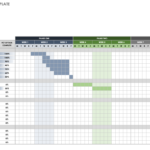Successfully completing any project within the time limit is crucial for any organization. Project planning ensures the same by providing all guiding documents and plans to help increase customer satisfaction and profit. Project planning plays an important role in reducing risks and failures. In this article, we will learn the basics of project planning, its fundamentals, tools, terms, steps, components, and techniques.
What Is a Project Planning?
A project plan is a set of official documents that describe the execution and control steps of a project. The plan comprises risk management, resource management, and communications, while also talking about the scope, cost, and schedule baselines. Various Project planning software is used by the Project management team to make sure that the plans are detailed and robust.
The project plan contains the following documents:
Project Charter: Gives a general overview of the project. It outlines the project’s intent and objectives as well as constraints and risks. It also defines who are the stakeholders, and the general execution strategy.
Scope of Work Statement (SOW): The SOW statement describes the project’s scope, schedule, activities and deliverables, and key milestones.
Work Breakdown Structure (WBS): WBS breaks down the project scope into the project phases, deliverables, and work packages that lead to the concluding deliverable.
Project Execution Plan (PEP): The PEP is a detailed document describing the execution strategy, roles and responsibilities, detailed schedule, project assurance, and risk management. PEP acts as the ultimate guiding document.
How to Create a Project Plan
A project plan is a crucial component to the success of any project. Without one, your project may be vulnerable to common project management issues such as missed time limits, scope miss, and overrun of budget. While developing a project plan is a bit exhaustive, the effort will pay off during the project life cycle.
The basic outline of the project plan is explained in these steps:
- Identify and write down your project’s stakeholders, scope, quality baseline, deliverables, milestones, success criteria, and requirements. Develop a project charter, a statement of work (SOW), and a work breakdown structure (WBS).
- Collectively identify and define the risks. Assign deliverables to your team members, who will execute the tasks required and monitor the risks associated with them.
- Establish your project team i.e., define all stakeholders including customers, team members, ad hoc members, supporting team, etc., and define their roles and responsibilities.
- List the essential project resources, such as personnel, equipment, salaries, materials, etc., and consider the budgets for the same.
- Define procedures for the management of change.
- Develop a communication plan, schedule, and budget along with other important guiding documents for the project.
Project Planning Phase
The project planning process is crucial for any project. All the required documents to provide guidance on the execution philosophy of the project are generated during project planning. It also informs how the risks will be controlled and how any issues that might occur will be resolved throughout the project cycle. These documents shall cover all the details of the project without exception.
Project Planning Terms
The following list gives an idea about commonly referred terms in the Project Plan.
- Deliverable: Outcome of an activity. Can be a document, drawing report, etc.
- Stakeholder: Anyone having a conferred interest in the project. It can be the customer, project manager, any team member, etc.
- Tasks: Smaller work item
- Milestone: Any key or important event in the project
- Resources: Whatever is required to execute the project in terms of personnel, machines, tools, stationery, capital, etc.
- Budget: Estimated monetary cost of the project
- Tracking & Monitoring: Collecting the data to ensure the project is on track as planned.
Project Planning Steps
Following are the main steps generally followed to create a Project Plan.
- Defining the business case
- Meeting with key stakeholders
- Laying out the project scope
- Assembling a project team
- Defining a project budget
- Setting the project goals
- Defining the project deliverables
- Preparing a project schedule
- Assigning tasks to the team members
- Performing a risk analysis
- Compiling the project plan
Main Components of the Project Management Plan
At its very elementary level, a project plan consists of three main components.
Activities
What exactly your team will need to do in order to complete the project? Activities in the project plan shall include items like:
- Progress measurement
- task delegation
- resource allocation
- Keeping track of time spent on project tasks
- communicating regularly & effectively.
Tasks
The project is broken down into several doable tasks for convenience of execution. These are smaller work items that collectively make up your project. Having small incremental work items makes measuring and addressing bottlenecks simpler. Identification of these tasks is vital to making a good project management plan.
Resources
Resources will include team members, experts, machines, tools, budgets, etc. Identification of the right resources and the timeline when these resources need to be mobilized and de-mobilized is crucial from the project’s profit margin perspective.
The Elements of a Project Plan
The project planning process discussed till now only shows the surface. A good Project Plan is a lot more detailed. PMI’s PMBOK Guide (Guide to the Project Management Body of Knowledge) describes that the project plan shall include the following at a minimum:
- A project scope statement
- A risk management plan
- A change management plan
- A cost management plan
- A resource management plan
- A stakeholder management plan
- A quality plan
What are some project planning tools and software?
To facilitate the project planning process, Project planning and project management software are widely used. Some of the best project planning software tools are listed here:
- Asana
- ClickUp
- Freedcamp
- Hive
- Scoro
- Trello
- Wrike
- Primavera P6
- Microsoft Projects
Project Planning Techniques
Project planning tools help us to keep track of project timelines and resource requirements. A list of some of the most widespread techniques:
Gantt Chart: Gantt charts are an industry norm that assists in tracking interdependencies between activities as well as durations. Gantt charts are an important tool to represent different phases, activities, durations, and resources involved in a project.
Critical Path Method (CPM): Critical Path Method (CPM) is a critical tool for defining the progress of the project to make sure that the project is on track. It helps in identifying the critical path by figuring out the longest chain of interdependent tasks that cannot be delayed.
PERT Chart: The Program Evaluation and Review Technique (PERT) helps in examining the activities to complete the project and the duration required to complete those. PERT is mostly used to simplify the planning and scheduling of large complex projects
Work Breakdown Structure (WBS): Work Breakdown Structure (WBS) is a method where activities are broken down into smaller and more manageable tasks. These tasks are easier to monitor and complete.
How To Manage Your Project Plan
The project plan is not the words carved in stone. One should be regularly referring back and making changes as needed. Sections like the project schedule will change frequently. Other sections such as cost management and procurement plan, may not change at all during the life of the project.
The significant thing to remember is that if the project management plan isn’t working, think about what can be changed to make it work. It is developed to guide in managing the project and not limiting from doing what is the right thing.
How To Make a Project Plan When All the details are not available
It is absolutely rare to have all the information at the commencement of a project. Most of the time it is expected to dive in and get started, but all the details are not known.
First comes assumption. These are used to put caution on a base plan and to document the things that are assumed to be true at this point in time based on previous experiences. Have these assumptions documented and get buy-in from all stakeholders. As the project progresses, more details start to surface. This is the time to make necessary changes to the Project Plan and adjust them accordingly. This also goes hand in hand with WBS explained earlier. Smaller tasks will make it easier to adjust to the changes if any.
Conclusion
Project planning makes sure that the budget and schedule are monitored at every step. It also makes sure that timely testing of the output is done at every step. Moreover, project planning supports analyzing, prioritizing, and ensuring a suitable plan for all types of risks. Proper planning guarantees that if there are multiple risks, they can be arranged based on priorities and dealt with accordingly. The Project plan acts as a guiding document and makes it convenient for the project team to address all the crucial details and deadlines.






